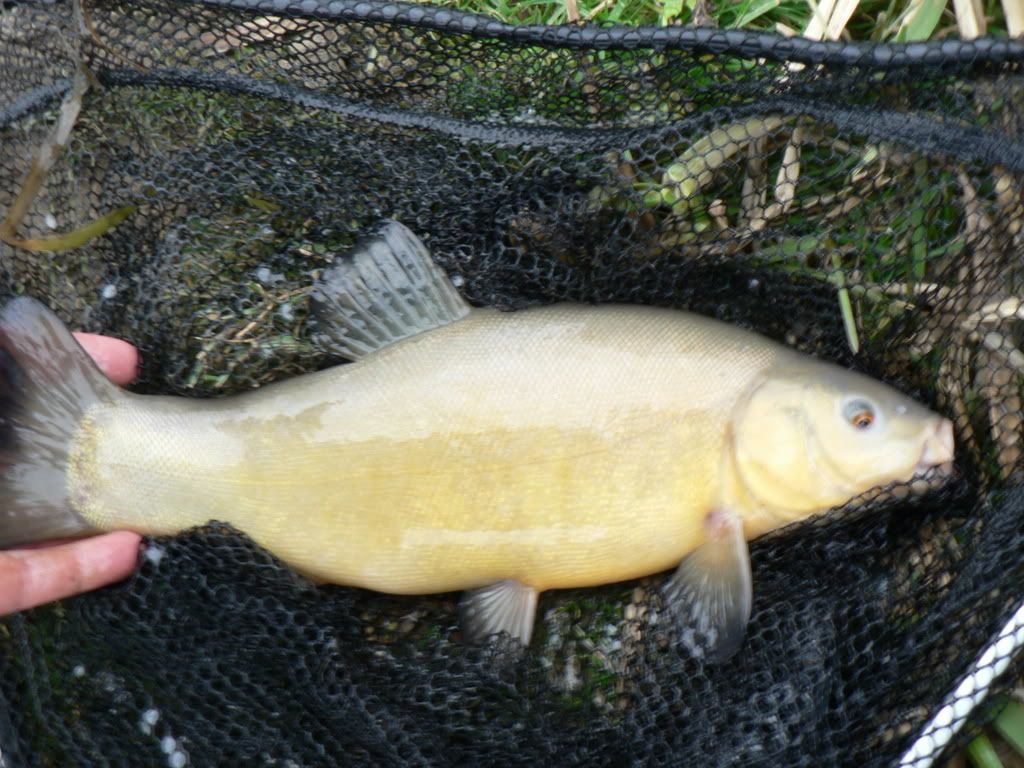As previously reported By Peter on Maggotdrowning:
http://www.maggotdrowning.com/forum/topic.asp?TOPIC_ID=66562
The object of the exercise was to carry forward what I’d learnt on my first session with the waggler (previously blogged). There were a number of issues to address – what sort of waggler for which conditions, shotting patterns, that sort of thing, and I started off by showing Peter my float-box. He suggested I try an insert peacock carrying 4 AAA and in addition to the bulk, to shot it with a couple of number 8s – one about half-way down, the other nine inches or so from the hook. This was a fairly heavy rig (as wagglers go), unlike the little six-inch jobbies I’d got which only take a few shot to cock them; it was so windy, even the heavy waggler was a job to cast.
Peter was out of the blocks almost immediately and was into a little run of skimmers;

unfortunately, the shoal must have moved off as their presence was short-lived. I managed to bag one but as usual was falling way behind Peter’s catch-rate. A problem I identified almost immediately was visibility.
I tried to match the distance Peter was casting – quite a long way for float-fishing, about twenty-five meters or so, maybe thirty – I’m not too sure, it seemed an awful long way though and I have to confess I really couldn’t see the float properly and often not at all. Although the fine tip of the insert is great for lack of resistance to a biting fish, its slimness was a real disadvantage to the optically-challenged such as myself. I struggled with the thing for a good couple of hours before finally admitting defeat and fished shorter – even picking up a couple of fish. As Peter continued to reel ‘em in from his long-range presentation I changed the float for something else.
I’d got several other patterns with me, mostly of the straight variety made of reed, clear plastic, and peacock quill, but after several changes I eventually settled on a Premier Windbeater with a balsa body and straight stem carrying a shed-load of lead. At least this was manageable in the extremely strong wind which got stronger as the day wore on. I finally got the visibility issue sorted and could see the bright orange of the tip pretty well and with some fiddling about managed to get the shotting about right too. Peter however had out-caught me by a ratio of about five to one and I began to get ever so slightly frustrated by my lack of action – whereas Peter was picking up fish (albeit the odd fish, but fish nonetheless) a matter of only a few metres away.

Peter of course had the reason – and not for the first time during our sessions together it was FEEDING.
If there is one thing that is more important than anything else it is giving the fish feed in a consistent and regular manner sufficient to keep them interested in looking around for and finding hookbaits. Almost every time we go fishing, Feeding is the number one issue and today was no different. Peter reckoned it was my carp-fisherman mindset that made me adopt the sit-and-wait style I was using – whereas he was always busy, either feeding, twitching the bait back, re-casting, re-baiting, casting spells, talking to the fish – and whatever other devices he employs to coax, cajole, and coerce fish into taking his bait.
True, twitching the bait by giving the reel handle a turn every minute or so I am sure persuades an otherwise disinterested fish to snatch the bait back, but it is the constant and continual investment of effort that really does the trick, an investment that resulted in Peter far out-fishing me.
It was not only the amount and frequency of feed going in that made a difference – but where it was going also. Peter was pin-pointedly accurate – even in what was at times, a howling wind; my catapulted maggots were often going all over the place, blown by a gusty wind veering in sometimes unpredictable directions. There is a definite knack to it – you must aim low and snappy, not high and gentle – allowing the wind to blow the feed near the float, for it will inevitably blow it exactly where you don’t want it. The feed must be little, often, and in exactly the right place. Easy to talk – more difficult to do.
The carp was a total fluke and I claim no great skill in either luring it or landing it. The skimmers fought ten times harder! I am convinced the fish must have been laying-up – and for some considerable time too as it had a number of leech-like organisms on it.

Carp lay-up in the very harsh weather and I have often noticed that sick or mangy fish are particularly prone to doing this. The one I caught was a very sad individual who had obviously had a hard summer – the evidence of disease was obvious – lesions, partially rotten fins, and poor condition resulting in a fish that was in the recovery stage of previous ill-health.
Peter had to go early as his leg was playing him up (poor old thing) and I spent the last hour doing much better than the previous few hours catching some of the Chub and this Tench.

All in all, not only an enjoyable day in good company, but once again, I learnt a lot from my ‘mentor’.
Thanks Peter.




No comments:
Post a Comment